|
mutLBSgeneDB |
| |
| |
| |
| |
| |
| |
|
| Gene summary for PDE2A |
 Gene summary Gene summary |
| Basic gene Info. | Gene symbol | PDE2A |
| Gene name | phosphodiesterase 2A, cGMP-stimulated | |
| Synonyms | CGS-PDE|PDE2A1|PED2A4|cGSPDE | |
| Cytomap | UCSC genome browser: 11q13.4 | |
| Type of gene | protein-coding | |
| RefGenes | NM_001143839.3, NM_001146209.2,NM_001243784.1,NM_002599.4, | |
| Description | cGMP-dependent 3',5'-cyclic phosphodiesterasecGMP-stimulated phosphodiesterase 1cGMP-stimulated phosphodiesterase 4cyclic GMP-stimulated phosphodiesterase | |
| Modification date | 20141207 | |
| dbXrefs | MIM : 602658 | |
| HGNC : HGNC | ||
| Ensembl : ENSG00000186642 | ||
| HPRD : 04041 | ||
| Vega : OTTHUMG00000102045 | ||
| Protein | UniProt: O00408 go to UniProt's Cross Reference DB Table | |
| Expression | CleanEX: HS_PDE2A | |
| BioGPS: 5138 | ||
| Pathway | NCI Pathway Interaction Database: PDE2A | |
| KEGG: PDE2A | ||
| REACTOME: PDE2A | ||
| Pathway Commons: PDE2A | ||
| Context | iHOP: PDE2A | |
| ligand binding site mutation search in PubMed: PDE2A | ||
| UCL Cancer Institute: PDE2A | ||
| Assigned class in mutLBSgeneDB | A: This gene has a literature evidence and it belongs to targetable_mutLBSgenes. | |
| References showing study about ligand binding site mutation for PDE2A. | 1. Heikaus, C. C., Stout, J. R., Sekharan, M. R., Eakin, C. M., Rajagopal, P., Brzovic, P. S., ... & Klevit, R. E. (2008). Solution Structure of the cGMP Binding GAF Domain from Phosphodiesterase 5 INSIGHTS INTO NUCLEOTIDE SPECIFICITY, DIMERIZATION, AND cGMP-DEPENDENT CONFORMATIONAL CHANGE. Journal of Biological Chemistry, 283(33), 22749-22759. 18534985 | |
 Gene ontology having evidence of Inferred from Direct Assay (IDA) from Entrez Gene ontology having evidence of Inferred from Direct Assay (IDA) from Entrez |
| GO ID | GO Term | PubMed ID | GO:0000122 | negative regulation of transcription from RNA polymerase II promoter | 17329248 | GO:0006198 | cAMP catabolic process | 14687666 | GO:0008152 | metabolic process | 17329248 | GO:0033159 | negative regulation of protein import into nucleus, translocation | 17329248 | GO:0036006 | cellular response to macrophage colony-stimulating factor stimulus | 14687666 | GO:0046069 | cGMP catabolic process | 14687666 | GO:0071321 | cellular response to cGMP | 17704206 | GO:0097011 | cellular response to granulocyte macrophage colony-stimulating factor stimulus | 14687666 |
| Top |
| Ligand binding site mutations for PDE2A |
 Lollipop-style diagram of mutations at LBS in amino-acid sequence. Lollipop-style diagram of mutations at LBS in amino-acid sequence. We represented ligand binding site mutations only. (You can see big image via clicking.) |
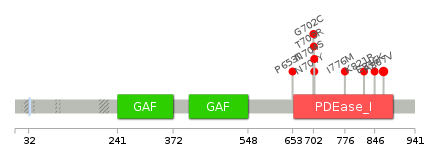 |
 Cancer type specific mutLBS sorted by frequency Cancer type specific mutLBS sorted by frequency |
| LBS | AAchange of nsSNV | Cancer type | # samples | I866 | A867V | COAD | 1 | I822 | K821R | KIRC | 1 | N704 | T703R | LUAD | 1 | N704 | N704S | LUAD | 1 | L774 | I776M | LUSC | 1 | Y655 | P653T | LUSC | 1 | I866 | A867V | OV | 1 | M847,M845 | E846K | SKCM | 1 | N704 | N704Y | STAD | 1 | N704,H700 | G702C | UCEC | 1 |
| cf) Cancer type abbreviation. BLCA: Bladder urothelial carcinoma, BRCA: Breast invasive carcinoma, CESC: Cervical squamous cell carcinoma and endocervical adenocarcinoma, COAD: Colon adenocarcinoma, GBM: Glioblastoma multiforme, LGG: Brain lower grade glioma, HNSC: Head and neck squamous cell carcinoma, KICH: Kidney chromophobe, KIRC: Kidney renal clear cell carcinoma, KIRP: Kidney renal papillary cell carcinoma, LAML: Acute myeloid leukemia, LUAD: Lung adenocarcinoma, LUSC: Lung squamous cell carcinoma, OV: Ovarian serous cystadenocarcinoma, PAAD: Pancreatic adenocarcinoma, PRAD: Prostate adenocarcinoma, SKCM: Skin cutaneous melanoma, STAD: Stomach adenocarcinoma, THCA: Thyroid carcinoma, UCEC: Uterine corpus endometrial carcinoma. |
| Top |
| Protein structure related information for PDE2A |
 Relative protein structure stability change (ΔΔE) using Mupro 1.1 Relative protein structure stability change (ΔΔE) using Mupro 1.1 Mupro score denotes assessment of the effect of mutations on thermodynamic stability. (ΔΔE<0: mutation decreases stability, ΔΔE>0: mutation increases stability) |
 : nsSNV at non-LBS : nsSNV at non-LBS : nsSNV at LBS : nsSNV at LBS |
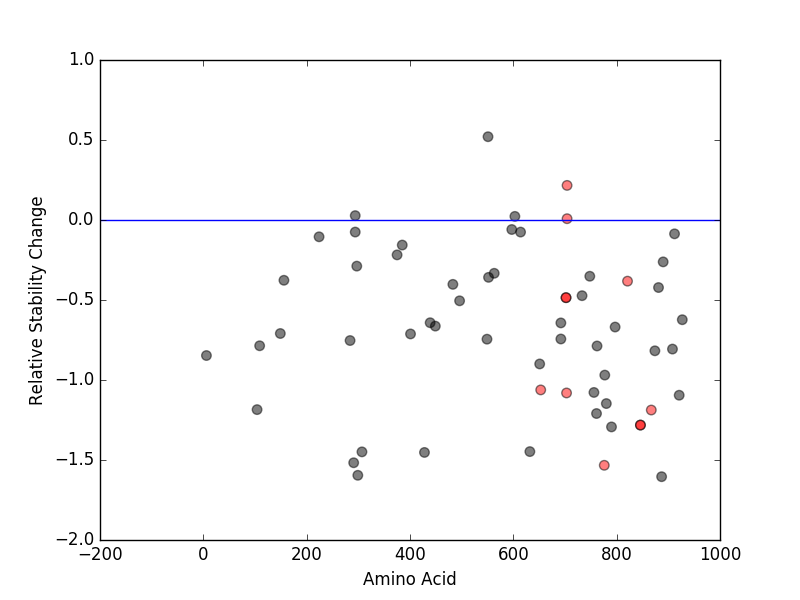 |
 nsSNVs sorted by the relative stability change of protein structure by each mutation nsSNVs sorted by the relative stability change of protein structure by each mutation Blue: mutations of positive stability change. and red : the most recurrent mutation for this gene. |
| LBS | AAchange of nsSNV | Relative stability change | N704 | N704Y | 0.21625259 | N704 | N704S | 0.008137558 | L774 | I776M | -1.5330969 | M845 | E846K | -1.2817133 | M847 | E846K | -1.2817133 | I866 | A867V | -1.1876784 | N704 | T703R | -1.0810062 | Y655 | P653T | -1.0619263 | N704 | G702C | -0.48538548 | H700 | G702C | -0.48538548 | I822 | K821R | -0.38224486 |
| (MuPro1.1: Jianlin Cheng et al., Prediction of Protein Stability Changes for Single-Site Mutations Using Support Vector Machines, PROTEINS: Structure, Function, and Bioinformatics. 2006, 62:1125-1132) |
 Structure image for PDE2A from PDB Structure image for PDE2A from PDB |
| Top |
| Differential gene expression and gene-gene network for PDE2A |
 Differential gene expression between mutated and non-mutated LBS samples in all 16 major cancer types Differential gene expression between mutated and non-mutated LBS samples in all 16 major cancer types |
 Differential co-expressed gene network based on protein-protein interaction data (CePIN) Differential co-expressed gene network based on protein-protein interaction data (CePIN) |
| Top |
| Top |
| Phenotype information for PDE2A |
 Gene level disease information (DisGeNet) Gene level disease information (DisGeNet) |
| Disease ID | Disease name | # PubMed | Association type |
| umls:C1458155 | Breast Neoplasms | 1 | Biomarker |
 Mutation level pathogenic information (ClinVar annotation) Mutation level pathogenic information (ClinVar annotation) |
| Allele ID | AA change | Clinical significance | Origin | Phenotype IDs |
| Top |
| Pharmacological information for PDE2A |
 Gene expression profile of anticancer drug treated cell-lines (CCLE) Gene expression profile of anticancer drug treated cell-lines (CCLE)Heatmap showing the correlation between gene expression and drug response across all the cell-lines. We chose the top 20 among 138 drugs.We used Pearson's correlation coefficient. |
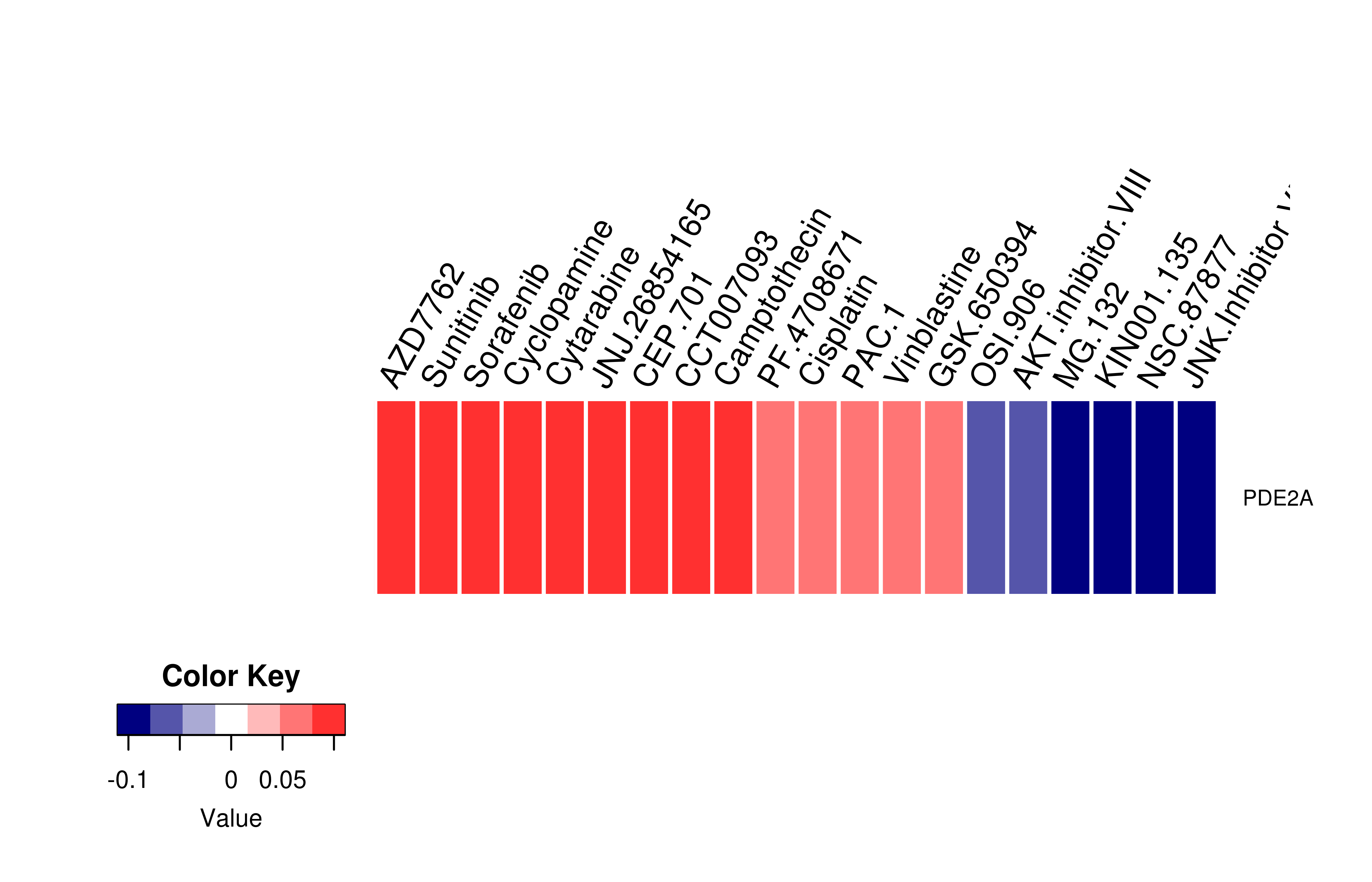 |
 Gene-centered drug-gene interaction network Gene-centered drug-gene interaction network |
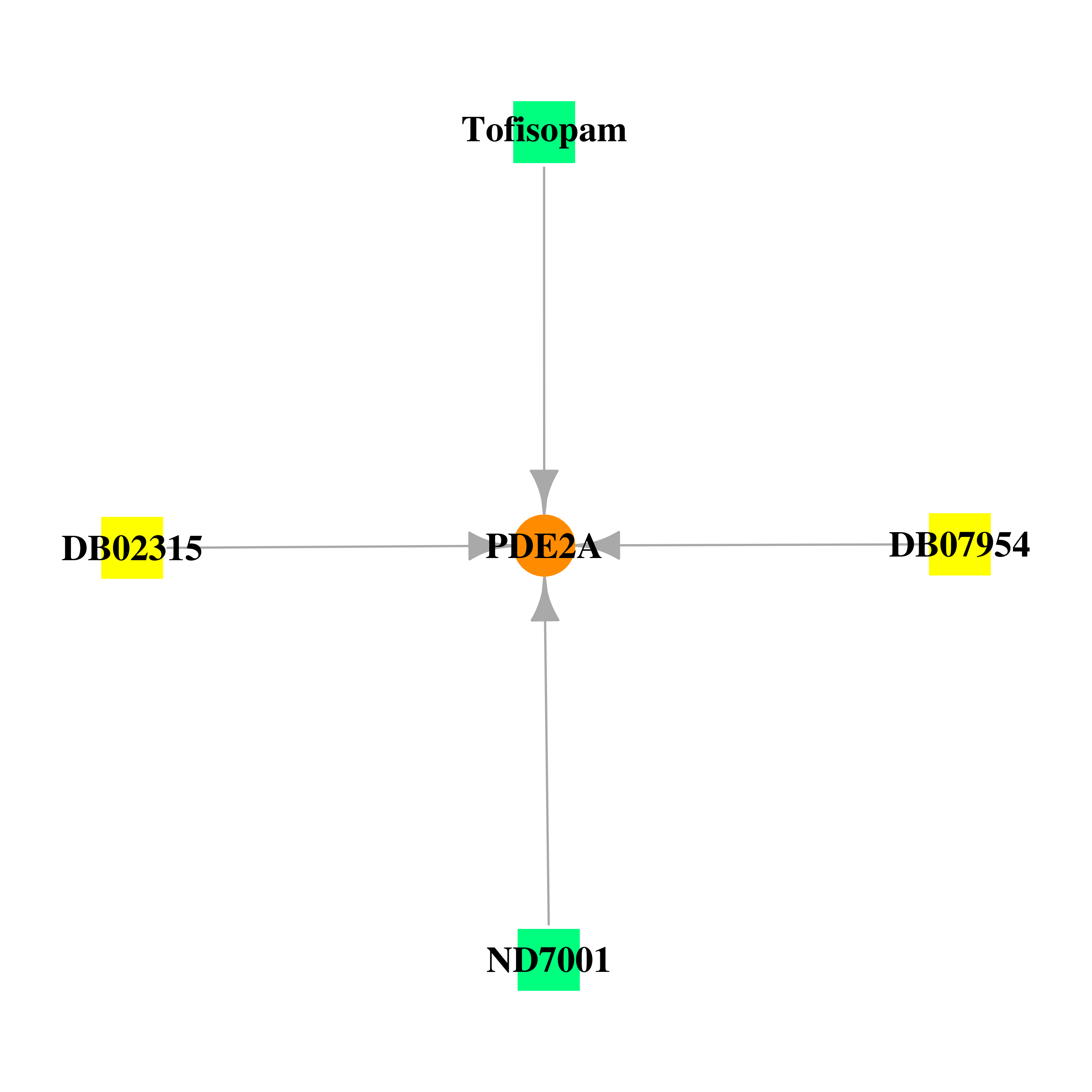 |
 Drug information targeting mutLBSgene (Approved drugs only) Drug information targeting mutLBSgene (Approved drugs only) |
| Drug status | DrugBank ID | Name | Type | Drug structure |
| Experimental | DB02315 | Cyclic Guanosine Monophosphate | Small molecule | 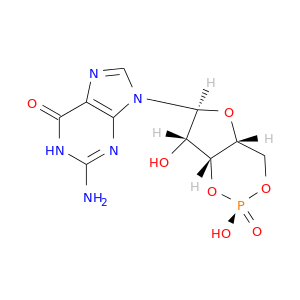 |
| Investigational | DB05142 | ND7001 | Small molecule |  |
| Experimental | DB07954 | 3-isobutyl-1-methyl-7H-xanthine | Small molecule | 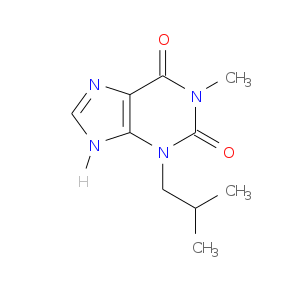 |
| Approved | DB08811 | Tofisopam | Small molecule | 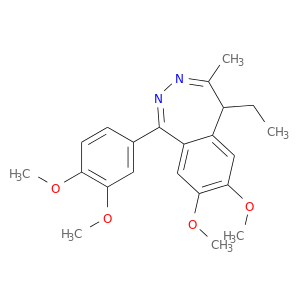 |
 Gene-centered ligand-gene interaction network Gene-centered ligand-gene interaction network |
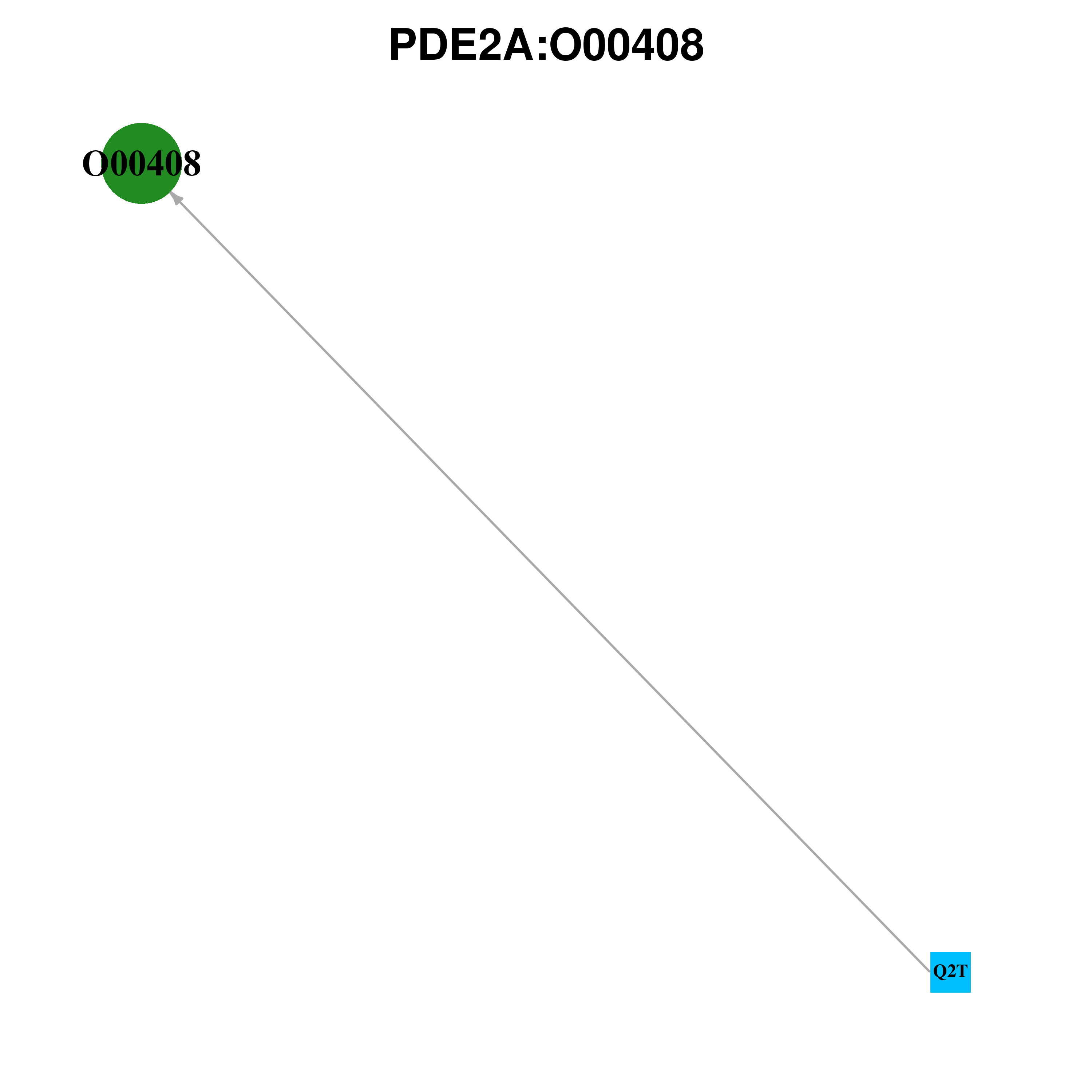 |
 Ligands binding to mutated ligand binding site of PDE2A go to BioLip Ligands binding to mutated ligand binding site of PDE2A go to BioLip |
| Ligand ID | Ligand short name | Ligand long name | PDB ID | PDB name | mutLBS | MG | MAGNESIUM(2+) | 4d09 | C | H700 | MG | MAGNESIUM(2+) | 4d09 | D | H700 | EH9 | (2S,3R)-EHNA | 4c1i | D | I866 | 788 | N-BENZYL-4-METHYL-1-PHENYL[1,2,4]TRIAZOLO[4, 3-A]QUINOXALINE-8-CARBOXAMIDE | 4d09 | D | L774 I822 M847 | 788 | N-BENZYL-4-METHYL-1-PHENYL[1,2,4]TRIAZOLO[4, 3-A]QUINOXALINE-8-CARBOXAMIDE | 4d09 | A | L774 M847 | Q2T | 1-(5-BUTOXYPYRIDIN-3-YL)-4-METHYL-8- (MORPHOLIN-4-YLMETHYL)[1,2,4]TRIAZOLO[4,3-A] QUINOXALINE | 4d08 | C | M845 M847 | 788 | N-BENZYL-4-METHYL-1-PHENYL[1,2,4]TRIAZOLO[4, 3-A]QUINOXALINE-8-CARBOXAMIDE | 4d09 | B | M847 | Q2T | 1-(5-BUTOXYPYRIDIN-3-YL)-4-METHYL-8- (MORPHOLIN-4-YLMETHYL)[1,2,4]TRIAZOLO[4,3-A] QUINOXALINE | 4d08 | D | N704 M845 M847 | Q2T | 1-(5-BUTOXYPYRIDIN-3-YL)-4-METHYL-8- (MORPHOLIN-4-YLMETHYL)[1,2,4]TRIAZOLO[4,3-A] QUINOXALINE | 4d08 | A | N704 M847 | Q2T | 1-(5-BUTOXYPYRIDIN-3-YL)-4-METHYL-8- (MORPHOLIN-4-YLMETHYL)[1,2,4]TRIAZOLO[4,3-A] QUINOXALINE | 4d08 | B | N704 M847 | IBM | 3-ISOBUTYL-1-METHYL-9H-XANTHINE | 3itu | B | Y655 | IBM | 3-ISOBUTYL-1-METHYL-9H-XANTHINE | 3itu | C | Y655 | IBM | 3-ISOBUTYL-1-METHYL-9H-XANTHINE | 3itu | D | Y655 | EH9 | (2S,3R)-EHNA | 4c1i | A | Y655 | EH9 | (2S,3R)-EHNA | 4c1i | C | Y655 | 1L6 | 1-(2-HYDROXYETHYL)-3-(2-METHYLBUTAN-2-YL)-5-[4-(2- METHYL-1H-IMIDAZOL-1-YL)PHENYL]-6,7-DIHYDROPYRAZOLO[4, 3-E][1,4]DIAZEPIN-8(1H)-ONE | 4jib | B | Y655 I822 M847 I866 | EH9 | (2S,3R)-EHNA | 4c1i | B | Y655 I866 | 788 | N-BENZYL-4-METHYL-1-PHENYL[1,2,4]TRIAZOLO[4, 3-A]QUINOXALINE-8-CARBOXAMIDE | 4d09 | C | Y655 L774 M847 I866 | IBM | 3-ISOBUTYL-1-METHYL-9H-XANTHINE | 3itu | A | Y655 M847 | 1L6 | 1-(2-HYDROXYETHYL)-3-(2-METHYLBUTAN-2-YL)-5-[4-(2- METHYL-1H-IMIDAZOL-1-YL)PHENYL]-6,7-DIHYDROPYRAZOLO[4, 3-E][1,4]DIAZEPIN-8(1H)-ONE | 4jib | A | Y655 M847 | 1L6 | 1-(2-HYDROXYETHYL)-3-(2-METHYLBUTAN-2-YL)-5-[4-(2- METHYL-1H-IMIDAZOL-1-YL)PHENYL]-6,7-DIHYDROPYRAZOLO[4, 3-E][1,4]DIAZEPIN-8(1H)-ONE | 4jib | C | Y655 M847 | 1L6 | 1-(2-HYDROXYETHYL)-3-(2-METHYLBUTAN-2-YL)-5-[4-(2- METHYL-1H-IMIDAZOL-1-YL)PHENYL]-6,7-DIHYDROPYRAZOLO[4, 3-E][1,4]DIAZEPIN-8(1H)-ONE | 4jib | D | Y655 M847 | 19F | BAY60-7550 | 2-(3,4-DIMETHOXYBENZYL)-7-[(2R,3R)-2-HYDROXY-6- PHENYLHEXAN-3-YL]-5-METHYLIMIDAZO[5,1-F][1,2, 4]TRIAZIN-4(3H)-ONE | 4htx | A | Y655 M847 I866 | 19F | BAY60-7550 | 2-(3,4-DIMETHOXYBENZYL)-7-[(2R,3R)-2-HYDROXY-6- PHENYLHEXAN-3-YL]-5-METHYLIMIDAZO[5,1-F][1,2, 4]TRIAZIN-4(3H)-ONE | 4htx | B | Y655 M847 I866 | 19F | BAY60-7550 | 2-(3,4-DIMETHOXYBENZYL)-7-[(2R,3R)-2-HYDROXY-6- PHENYLHEXAN-3-YL]-5-METHYLIMIDAZO[5,1-F][1,2, 4]TRIAZIN-4(3H)-ONE | 4htx | C | Y655 M847 I866 | 19F | BAY60-7550 | 2-(3,4-DIMETHOXYBENZYL)-7-[(2R,3R)-2-HYDROXY-6- PHENYLHEXAN-3-YL]-5-METHYLIMIDAZO[5,1-F][1,2, 4]TRIAZIN-4(3H)-ONE | 4htx | D | Y655 M847 I866 |
| Top |
| Conservation information for LBS of PDE2A |
 Multiple alignments for O00408 in multiple species Multiple alignments for O00408 in multiple species |
| LBS | AA sequence | # species | Species | D697 | SCMCHDLDHRG | 3 | Homo sapiens, Rattus norvegicus, Bos taurus | D808 | LMTSCDLSDQT | 3 | Homo sapiens, Rattus norvegicus, Bos taurus | D811 | SCDLSDQTKGW | 3 | Homo sapiens, Rattus norvegicus, Bos taurus | E727 | EGSVMERHHFA | 3 | Homo sapiens, Rattus norvegicus, Bos taurus | F830 | LIYKEFFSQGD | 3 | Homo sapiens, Rattus norvegicus, Bos taurus | F862 | ELQISFMEHIA | 3 | Homo sapiens, Rattus norvegicus, Bos taurus | H656 | RDPPYHNWMHA | 3 | Homo sapiens, Rattus norvegicus, Bos taurus | H660 | YHNWMHAFSVS | 3 | Homo sapiens, Rattus norvegicus, Bos taurus | H696 | ISCMCHDLDHR | 3 | Homo sapiens, Rattus norvegicus, Bos taurus | H700 | CHDLDHRGTNN | 3 | Homo sapiens, Rattus norvegicus, Bos taurus | H730 | VMERHHFAQAI | 3 | Homo sapiens, Rattus norvegicus, Bos taurus | H773 | TDLAHHLRIFK | 3 | Homo sapiens, Rattus norvegicus, Bos taurus | I822 | KTTRKIAELIY | 3 | Homo sapiens, Rattus norvegicus, Bos taurus | I826 | KIAELIYKEFF | 3 | Homo sapiens, Rattus norvegicus, Bos taurus | I866 | SFMEHIAMPIY | 3 | Homo sapiens, Rattus norvegicus, Bos taurus | I870 | HIAMPIYKLLQ | 3 | Homo sapiens, Rattus norvegicus, Bos taurus | L770 | ILATDLAHHLR | 3 | Homo sapiens, Rattus norvegicus, Bos taurus | L774 | DLAHHLRIFKD | 3 | Homo sapiens, Rattus norvegicus, Bos taurus | L809 | MTSCDLSDQTK | 3 | Homo sapiens, Rattus norvegicus, Bos taurus | L858 | AYIPELQISFM | 3 | Homo sapiens, Rattus norvegicus, Bos taurus | M845 | MGNRPMEMMDR | 3 | Homo sapiens, Rattus norvegicus, Bos taurus | M847 | NRPMEMMDREK | 3 | Homo sapiens, Rattus norvegicus, Bos taurus | M848 | RPMEMMDREKA | 3 | Homo sapiens, Rattus norvegicus, Bos taurus | N704 | DHRGTNNSFQV | 3 | Homo sapiens, Rattus norvegicus, Bos taurus | Q812 | CDLSDQTKGWK | 3 | Homo sapiens, Rattus norvegicus, Bos taurus | Q859 | YIPELQISFME | 3 | Homo sapiens, Rattus norvegicus, Bos taurus | S721 | AALYSSEGSVM | 3 | Homo sapiens, Rattus norvegicus, Bos taurus | S861 | PELQISFMEHI | 3 | Homo sapiens, Rattus norvegicus, Bos taurus | T768 | DIILATDLAHH | 3 | Homo sapiens, Rattus norvegicus, Bos taurus | T805 | LCLLMTSCDLS | 3 | Homo sapiens, Rattus norvegicus, Bos taurus | Y655 | YRDPPYHNWMH | 3 | Homo sapiens, Rattus norvegicus, Bos taurus | Y827 | IAELIYKEFFS | 3 | Homo sapiens, Rattus norvegicus, Bos taurus |
 |
Copyright © 2016-Present - The University of Texas Health Science Center at Houston |
